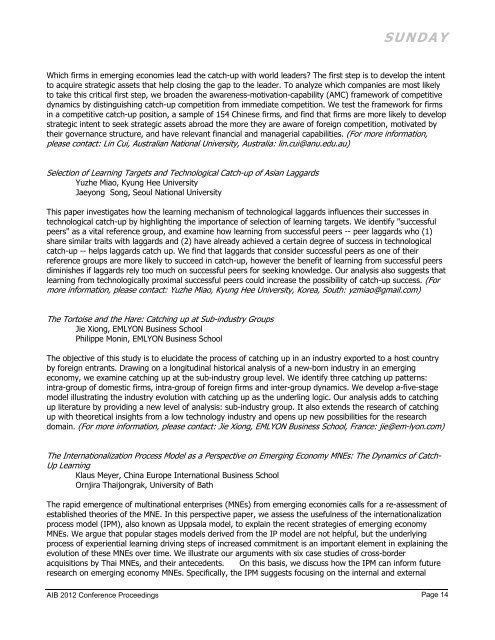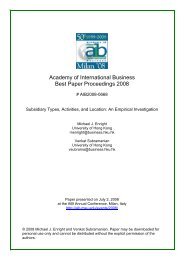AIB 2012 Conference Proceedings - Academy of International ...
AIB 2012 Conference Proceedings - Academy of International ...
AIB 2012 Conference Proceedings - Academy of International ...
You also want an ePaper? Increase the reach of your titles
YUMPU automatically turns print PDFs into web optimized ePapers that Google loves.
SUNDAY<br />
Which firms in emerging economies lead the catch-up with world leaders The first step is to develop the intent<br />
to acquire strategic assets that help closing the gap to the leader. To analyze which companies are most likely<br />
to take this critical first step, we broaden the awareness-motivation-capability (AMC) framework <strong>of</strong> competitive<br />
dynamics by distinguishing catch-up competition from immediate competition. We test the framework for firms<br />
in a competitive catch-up position, a sample <strong>of</strong> 154 Chinese firms, and find that firms are more likely to develop<br />
strategic intent to seek strategic assets abroad the more they are aware <strong>of</strong> foreign competition, motivated by<br />
their governance structure, and have relevant financial and managerial capabilities. (For more information,<br />
please contact: Lin Cui, Australian National University, Australia: lin.cui@anu.edu.au)<br />
Selection <strong>of</strong> Learning Targets and Technological Catch-up <strong>of</strong> Asian Laggards<br />
Yuzhe Miao, Kyung Hee University<br />
Jaeyong Song, Seoul National University<br />
This paper investigates how the learning mechanism <strong>of</strong> technological laggards influences their successes in<br />
technological catch-up by highlighting the importance <strong>of</strong> selection <strong>of</strong> learning targets. We identify "successful<br />
peers" as a vital reference group, and examine how learning from successful peers -- peer laggards who (1)<br />
share similar traits with laggards and (2) have already achieved a certain degree <strong>of</strong> success in technological<br />
catch-up -- helps laggards catch up. We find that laggards that consider successful peers as one <strong>of</strong> their<br />
reference groups are more likely to succeed in catch-up, however the benefit <strong>of</strong> learning from successful peers<br />
diminishes if laggards rely too much on successful peers for seeking knowledge. Our analysis also suggests that<br />
learning from technologically proximal successful peers could increase the possibility <strong>of</strong> catch-up success. (For<br />
more information, please contact: Yuzhe Miao, Kyung Hee University, Korea, South: yzmiao@gmail.com)<br />
The Tortoise and the Hare: Catching up at Sub-industry Groups<br />
Jie Xiong, EMLYON Business School<br />
Philippe Monin, EMLYON Business School<br />
The objective <strong>of</strong> this study is to elucidate the process <strong>of</strong> catching up in an industry exported to a host country<br />
by foreign entrants. Drawing on a longitudinal historical analysis <strong>of</strong> a new-born industry in an emerging<br />
economy, we examine catching up at the sub-industry group level. We identify three catching up patterns:<br />
intra-group <strong>of</strong> domestic firms, intra-group <strong>of</strong> foreign firms and inter-group dynamics. We develop a-five-stage<br />
model illustrating the industry evolution with catching up as the underling logic. Our analysis adds to catching<br />
up literature by providing a new level <strong>of</strong> analysis: sub-industry group. It also extends the research <strong>of</strong> catching<br />
up with theoretical insights from a low technology industry and opens up new possibilities for the research<br />
domain. (For more information, please contact: Jie Xiong, EMLYON Business School, France: jie@em-lyon.com)<br />
The <strong>International</strong>ization Process Model as a Perspective on Emerging Economy MNEs: The Dynamics <strong>of</strong> Catch-<br />
Up Learning<br />
Klaus Meyer, China Europe <strong>International</strong> Business School<br />
Ornjira Thaijongrak, University <strong>of</strong> Bath<br />
The rapid emergence <strong>of</strong> multinational enterprises (MNEs) from emerging economies calls for a re-assessment <strong>of</strong><br />
established theories <strong>of</strong> the MNE. In this perspective paper, we assess the usefulness <strong>of</strong> the internationalization<br />
process model (IPM), also known as Uppsala model, to explain the recent strategies <strong>of</strong> emerging economy<br />
MNEs. We argue that popular stages models derived from the IP model are not helpful, but the underlying<br />
process <strong>of</strong> experiential learning driving steps <strong>of</strong> increased commitment is an important element in explaining the<br />
evolution <strong>of</strong> these MNEs over time. We illustrate our arguments with six case studies <strong>of</strong> cross-border<br />
acquisitions by Thai MNEs, and their antecedents. On this basis, we discuss how the IPM can inform future<br />
research on emerging economy MNEs. Specifically, the IPM suggests focusing on the internal and external<br />
<strong>AIB</strong> <strong>2012</strong> <strong>Conference</strong> <strong>Proceedings</strong><br />
Page 14

















